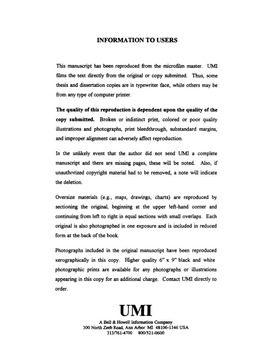| dc.contributor.advisor | Hanas, Jay S., | en_US |
| dc.contributor.author | Moreland, Rodney James. | en_US |
| dc.date.accessioned | 2013-08-16T12:30:09Z | |
| dc.date.available | 2013-08-16T12:30:09Z | |
| dc.date.issued | 1998 | en_US |
| dc.identifier.uri | https://hdl.handle.net/11244/5686 | |
| dc.description.abstract | The highly conserved C-terminal region of Xenopus TFIIIA was used in a yeast 2-hybrid screen to identify proteins that interact with this domain. This screen yielded a protein that interacts with Xenopus TFIIIA in yeast cells and in in vitro assays, including immunoprecipitations. The cDNA sequence of this protein revealed several motifs found in transcription factors such as a leucine zipper and a zinc finger. A function for this protein has not been defined, however, the protein has been localized to the nuclear membrane. | en_US |
| dc.description.abstract | Transcription factor IIIA (TFIIIA) is a RNA polymerase III factor that regulates eukaryotic 5S ribosomal RNA synthesis. This factor is the prototypical $\rm Cys\sb2His\sb2$ zinc finger protein, and its amino acid sequence is highly divergent among frog species. Xenopus TFIIIA will promote transcription of the 5S RNA gene in mammalian cell extracts. This suggests that the transcription activation domain is conserved between amphibians and mammals. To investigate this relationship, the TFIIIA amino acid sequence from mouse was identified, and its sequence has provided important structural and functional insights. Sequence analysis of mouse TFIIIA revealed a 20 amino acid region in the C-terminus that is highly conserved between mouse and amphibians, conversely, the N-terminal region demarcating the oocyte form of TFIIIA in frogs and fish is not conserved in mammals. | en_US |
| dc.description.abstract | The elongation stage of eukaryotic messenger RNA synthesis is a major site for the regulation of gene expression. Elongation factor Elongin is a member of a class of transcription factors that stimulates the rate of elongation by RNA polymerase II in vitro by suppressing transient pausing at many sites along DNA templates. Mechanistic studies of Elongin in this dissertation have shown the following: (1) Elongin does not stimulate detectably the rate of promoter-specific transcription initiation by the fully-assembled preinitiation complex; (2) early RNA polymerase II elongation intermediates first become susceptible to stimulation by Elongin after synthesizing 8-9 nucleotide-long transcripts; and (3) the relative inability of Elongin to stimulate elongation of transcripts less than 8-9 nucleotides correlates not with the lengths of their associated transcripts but, instead, with the presence of the initiation factor TFIIF in transcription reactions. | en_US |
| dc.format.extent | xi, 112 leaves : | en_US |
| dc.subject | Chemistry, Biochemistry. | en_US |
| dc.subject | Biology, Molecular. | en_US |
| dc.subject | RNA polymerases. | en_US |
| dc.subject | Amino acid sequence. | en_US |
| dc.title | Molecular interactions in RNA polymerase II and III transcription systems. | en_US |
| dc.type | Thesis | en_US |
| dc.thesis.degree | Ph.D. | en_US |
| dc.thesis.degreeDiscipline | Health Sciences Center | en_US |
| dc.note | Source: Dissertation Abstracts International, Volume: 59-08, Section: B, page: 4089. | en_US |
| dc.note | Major Professor: Jay S. Hanas. | en_US |
| ou.identifier | (UMI)AAI9900779 | en_US |
| ou.group | Health Sciences Center | |
